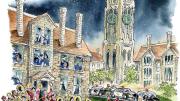1933
Permission for a pacifist meeting of the Harvard Liberal Club on the Widener steps on Armistice Day is denied by President Conant because “the courtesies of the Yard have already been extended” to West Point cadets in Cambridge for the football game. (Army won, 27-0.) The Widener steps, he adds, are available between 9 and 9:30 a.m., as are Harvard buildings outside the Yard throughout the day.
1938
Complaints by patients of Stillman Infirmary about “class D detective stories” have prompted the hygiene department, University library, and financial office to pledge $100, with a promise of $50 each succeeding year, until Stillman’s literary offerings are more acceptable.
1948
In a University-wide straw poll conducted by the Crimson, challenger Thomas Dewey defeats President Harry Truman 1,897 to 833. Faculty members pick Dewey five to one. Undeterred, the Crimson endorses Truman.
1953
The Band, en route to the Columbia game, gives a 3 a.m. concert at Yale that is cut short by the arrival of 12 New Haven police cars. Band manager Peter Strauss ’54 and a colleague are booked for disturbing the peace.
1968
Fury erupts at a December 3 faculty meeting when philosophy professor Hilary Putnam introduces an anti-ROTC resolution. Unusually high attendance has forced the meeting to be held in Sanders Theatre; outside, 250 students hand out leaflets and shout, “ROTC must go.”
1988
The University’s Association of Black Faculty and Administrators calls for an affirmative-action plan, involving recruitment and a capital campaign, to ensure that blacks, Hispanics, and Native Americans comprise 10 percent of its faculties by 1990, the centennial of the College graduation year of W.E.B. Du Bois, who became Harvard’s first black Ph.D. recipient in 1895.








